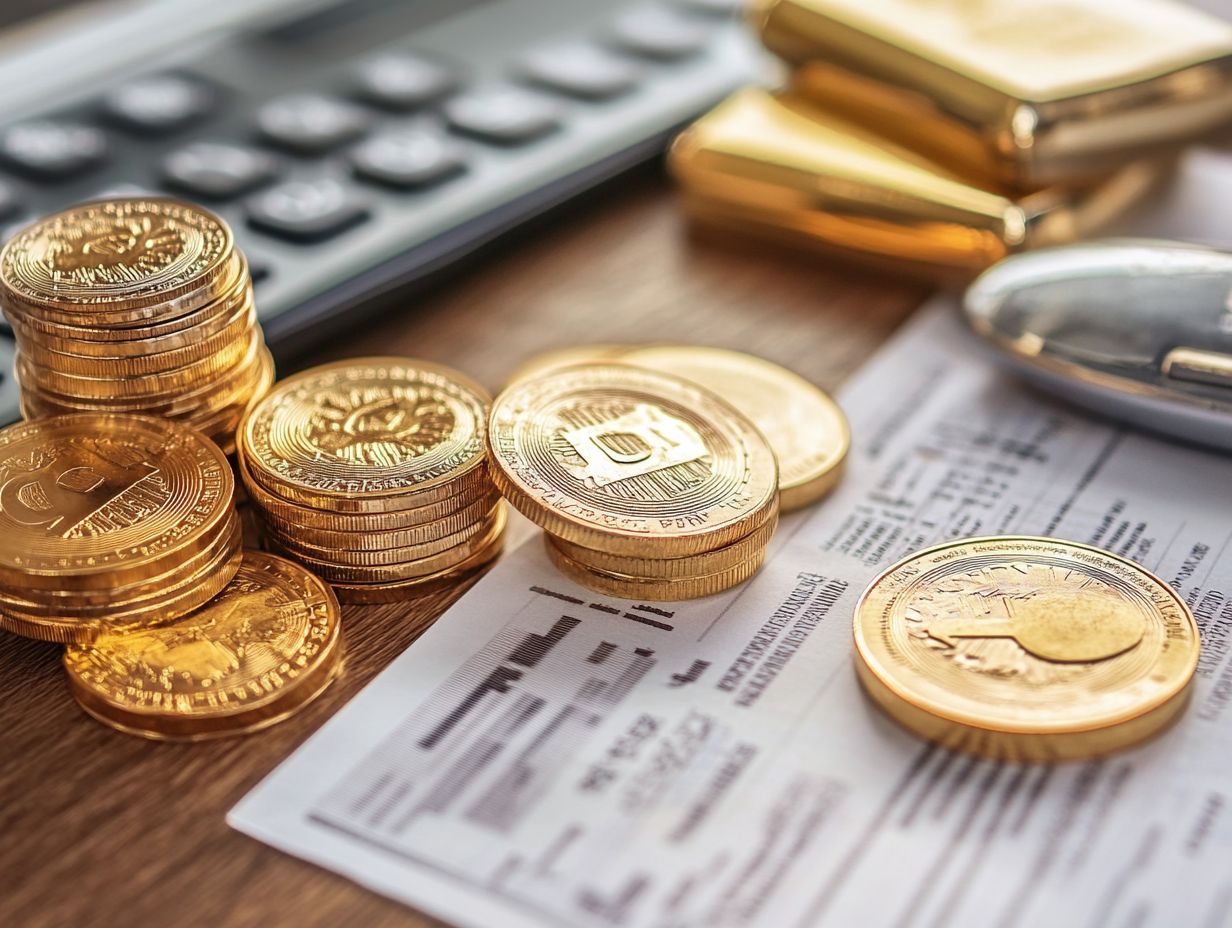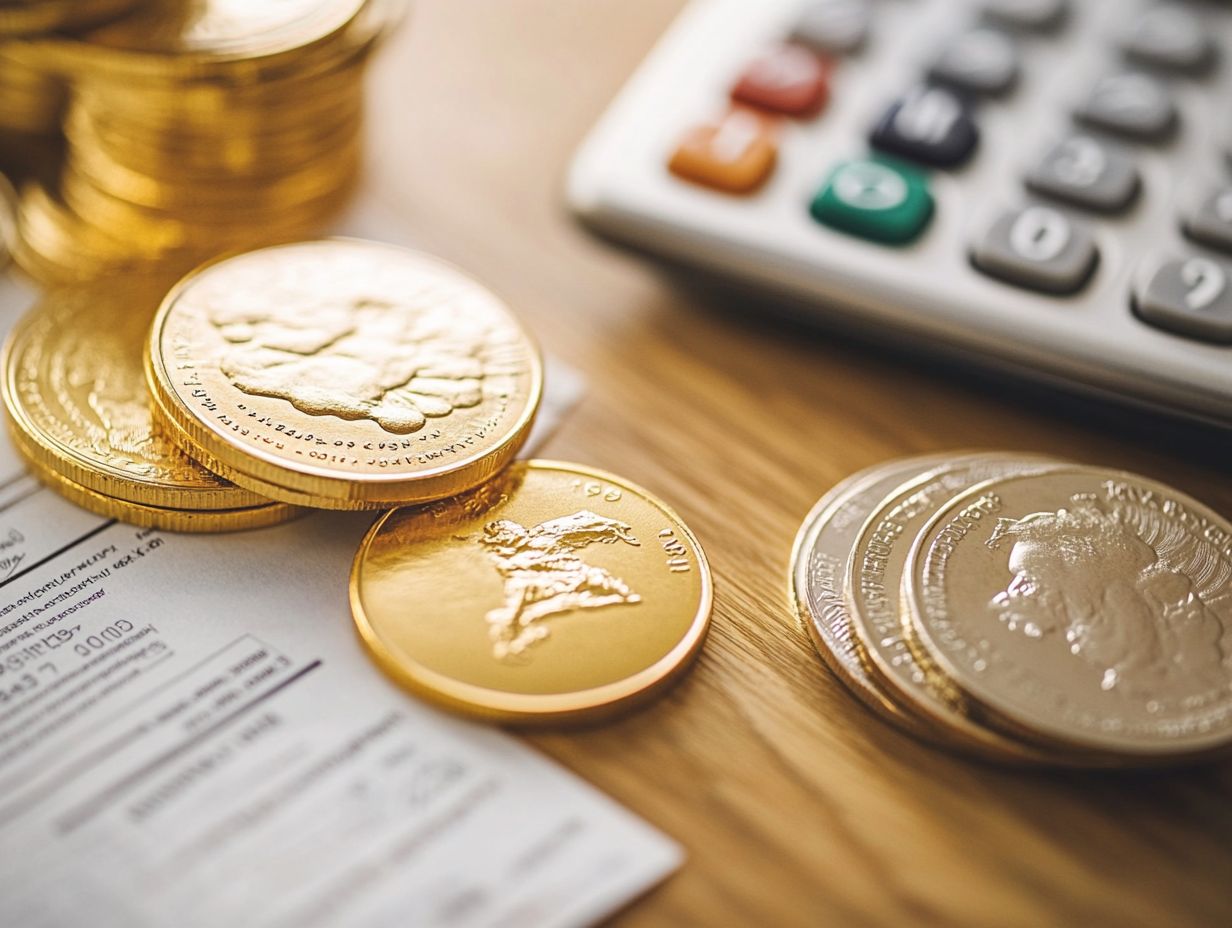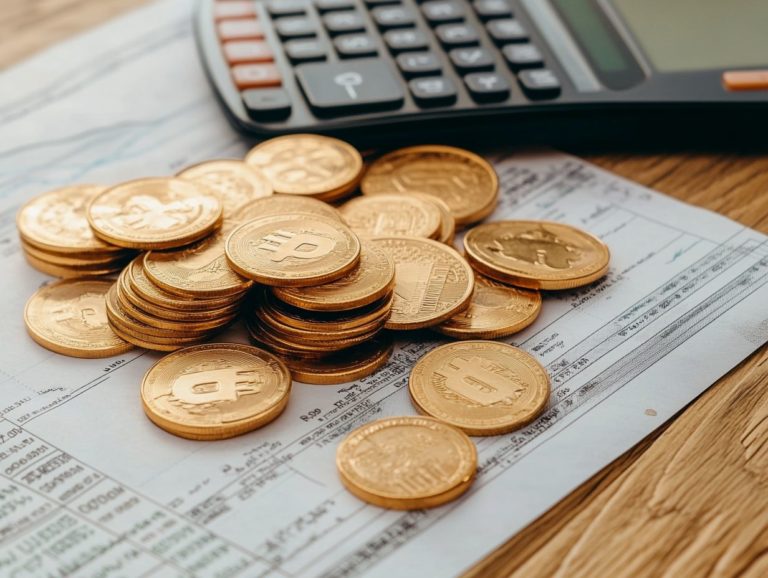The Role of Precious Metals in Tax-Deferred Accounts
Tax-deferred accounts present a savvy opportunity for you to grow your investments while postponing tax obligations. But have you considered the added advantage of diversifying your portfolio with precious metals?
This article delves into the different types of tax-deferred accounts and highlights the distinctive benefits that these investments can offer, such as serving as a safeguard against inflation.
Whether you re eager to discover which metals meet the criteria or how to effectively manage them within your account, this guide will equip you with all the essential information needed to make well-informed investment decisions.
Contents
- Key Takeaways:
- Understanding Tax-Deferred Accounts
- The Benefits of Including Precious Metals
- Types of Precious Metals Allowed in Tax-Deferred Accounts
- How to Add Precious Metals to Your Tax-Deferred Account
- Managing and Selling Precious Metals in Tax-Deferred Accounts
- Considerations Before Investing in Precious Metals for Tax-Deferred Accounts
- Frequently Asked Questions
- What are tax-deferred accounts?
- What is the role of precious metals in tax-deferred accounts?
- Can precious metals be held in tax-deferred accounts?
- Are there any tax advantages to holding precious metals in tax-deferred accounts?
- What are the risks of holding precious metals in tax-deferred accounts?
- Are there rules for holding precious metals in tax-deferred accounts?
Key Takeaways:

- Protect your portfolio from inflation and market downturns by diversifying with precious metals.
- Learn the step-by-step process to add and manage precious metals in your account.
- Evaluate the pros and cons of investing in precious metals and understand the selling rules.
Understanding Tax-Deferred Accounts
Tax-deferred accounts are essential in your financial planning arsenal. They enable you to grow your retirement funds without facing immediate tax implications.
Governed by IRS regulations, these accounts such as Traditional IRAs, Roth IRAs, and self-directed IRAs offer distinct benefits and limitations that can greatly influence your long-term investment strategies.
Understanding these accounts now is crucial for your financial future. Grasping the nuances of these accounts is vital for effective risk management, ensuring compliance with federal laws, and maximizing ways to save on taxes within your investment portfolio.
Definition and Types of Accounts
Tax-deferred accounts serve as ways to invest smartly that enable you to postpone paying taxes on your earnings until you withdraw them. This approach encourages long-term savings for retirement and other financial aspirations.
These accounts come in various forms, each tailored to meet distinct financial needs. For example, Traditional IRAs allow you to enjoy tax deductions on your contributions, effectively reducing your taxable income during your working years.
In contrast, Roth IRAs offer the allure of tax-free growth and withdrawals in retirement, making them particularly appealing if you expect your income to rise in the future.
Self-directed IRAs are particularly noteworthy; they grant you the flexibility to invest in a broader range of assets beyond the usual stocks and bonds, including real estate and precious metals. By grasping these unique characteristics, you can make informed decisions that optimize your retirement savings strategy.
The Benefits of Including Precious Metals
Imagine the possibilities! Incorporating precious metals such as gold and silver into your investment portfolio can provide a host of advantages. These assets offer diversification, acting as a shield against inflation, and serve as safe-haven investments during times of market volatility and economic uncertainty.
Embracing these elements can enhance your financial strategy. They ensure greater stability and resilience in your investments.
Diversification and Protection Against Inflation
Diversifying your portfolio with precious metals is a savvy strategy to mitigate risks tied to investment volatility and safeguard against inflation, giving you a cushion during economic instability.
By incorporating assets like gold and silver, you can tap into their historical performance, especially during times of rising prices and economic uncertainty. These metals have consistently demonstrated their value, often holding steady when traditional stocks and bonds may waver.
Their unique behavior in shifting market conditions showcases their potential to serve as a hedge, enabling you to navigate turbulent financial landscapes with increased confidence. This strategic addition not only enriches your investment mix but also aligns with your broader wealth preservation goals during unpredictable times.
Start exploring how precious metals can secure your future today!
Types of Precious Metals Allowed in Tax-Deferred Accounts

Tax-deferred accounts let you include various precious metals like gold, silver, platinum, and palladium. They must follow rules set by the IRS, ensuring your investments are compliant.
Gold, Silver, Platinum, and Palladium
Gold, silver, platinum, and palladium are top choices for precious metal IRAs. Each offers unique benefits that can boost your investment strategy.
Gold is often seen as a safe haven during tough economic times. It has a long history of stability and retains value, making it essential for any portfolio.
Silver serves as both an industrial metal and an investment option. It’s often more accessible for those looking to enter the precious metals market.
Platinum and palladium are less conventional but have surged in value due to their rarity and essential roles in automotive manufacturing. These are great options for savvy investors.
Together, these metals help you hedge against inflation. They allow you to respond to global market trends effectively.
How to Add Precious Metals to Your Tax-Deferred Account
Adding precious metals to your tax-deferred account requires careful planning. Start by selecting the right custodian and understanding withdrawal options for future distributions.
Each choice ensures your investments are secure and effective.
Step-by-Step Guide
Follow this step-by-step guide to add precious metals to your tax-deferred account. It covers compliance requirements and custodial choices.
First, research and select a reputable custodian specializing in precious metals. This choice affects both your investment’s safety and your ability to manage it.
Next, learn the IRS rules. They specify which metals you can include and their minimum purity levels. Also, be mindful of fees like transaction costs, storage expenses, and maintenance charges, as they impact your returns.
Understanding these steps helps you make informed decisions and optimize your investment strategy.
Managing and Selling Precious Metals in Tax-Deferred Accounts
Managing and selling precious metals in tax-deferred accounts requires understanding IRS rules, custody requirements, and investment risks. Equip yourself with this knowledge to navigate transactions successfully.
Rules and Regulations

Understanding the rules and regulations surrounding the management of precious metals in tax-deferred accounts is essential for your compliance and successful investment management.
It’s key to understand IRS rules to protect your investments. Navigating this landscape is crucial not just for preserving the tax advantages these accounts provide, but also for safeguarding against potential penalties.
Tax-deferred accounts like IRAs come with specific guidelines about the types of metals permitted, such as gold, silver, platinum, and palladium. So, it’s important for you to familiarize yourself with the purity standards and provenance requirements set by the IRS, as well as the role of precious metals in tax-advantaged accounts.
To ensure compliance, it s advisable to maintain accurate records and work with reputable custodians. These professionals can help you understand how to buy and sell precious metals. This proactive approach will not only mitigate compliance issues but also enhance the overall efficiency of your investment strategy.
Considerations Before Investing in Precious Metals for Tax-Deferred Accounts
Before you dive into investing in precious metals for tax-deferred accounts, take a moment to reflect on several key factors. Weigh the pros and cons carefully, assess potential market volatility, and evaluate how these investments fit into your broader investment strategy.
Making informed choices will set you on a path toward financial success.
Pros and Cons
Investing in precious metals presents a distinctive blend of advantages and disadvantages. They offer the allure of high returns as a hedge against inflation, while also introducing market risks and tax considerations that deserve your attention.
Many investors regard precious metals like gold and silver as a safe haven during times of economic turmoil. However, it’s essential to understand that their prices can be quite volatile, influenced by geopolitical tensions and fluctuations in currency strength.
The tax implications can vary widely based on how you choose to acquire and hold these assets, whether through physical ownership or ETFs (Exchange-Traded Funds). This complexity necessitates thoughtful evaluation of your long-term investment strategies, ensuring that the benefits of hedging against inflation do not overshadow the potential drawbacks tied to market volatility and tax liabilities.
Frequently Asked Questions
What are tax-deferred accounts?
Tax-deferred accounts are investment accounts that allow individuals to delay paying taxes on the earnings and gains from their investments until they withdraw the funds. This can help individuals save money on taxes in the present, although taxes will still apply when funds are withdrawn in the future.
What is the role of precious metals in tax-deferred accounts?

Precious metals, such as gold and silver, can play a valuable role in tax-deferred accounts. They offer a hedge against inflation and market volatility. These assets help diversify a portfolio and provide a safe haven for investors during times of economic uncertainty.
Can precious metals be held in tax-deferred accounts?
Yes, precious metals can be held in tax-deferred accounts, such as traditional and Roth IRAs, 401(k) plans, and self-directed IRAs. However, there may be restrictions on the types of precious metals that can be held and how they are stored. It s important to consult with a financial advisor or tax professional.
Are there any tax advantages to holding precious metals in tax-deferred accounts?
Yes, there can be tax advantages to holding precious metals in tax-deferred accounts. For example, if gold or silver is held in a Roth IRA, the gains from the investments can be tax-free when withdrawn in retirement. You may also deduct contributions to traditional IRAs or 401(k) plans from your taxable income, reducing your overall tax bill.
What are the risks of holding precious metals in tax-deferred accounts?
Holding precious metals in tax-deferred accounts comes with risks. You may face market fluctuations, storage fees, and limited access to your funds until you reach a certain age.
Are there rules for holding precious metals in tax-deferred accounts?
Yes, specific rules depend on the account type. These rules may limit the types of metals you can hold, how you store them, and how often you can trade.















